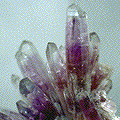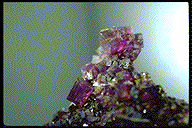FABULOUS MINERAL LOCALITIES
| |||

YUKON TERRITORY, CANADA |
 |
 |
 |
 |
 |
 |  KOLA PENNENSULA, RUSSIA |
There exists, in certain places around the world, areas that for one reason or another produce the most amazing assortment of minerals. These sites are well known to mineral collectors everywhere. The ones mentioned here are just some of those fabulous localities.
These sites are special for a number of reasons. They may be the type locality for a number of rare minerals. A 'type locality' is a site where the first specimens of a mineral were discovered and identified as a new mineral species. The sites mentioned here are type localities for several hundred mineral species. They also could each be a place where literally hundreds of different mineral species are found. Such a site is very scarce since most mineral sites rarely have a dozen different minerals. They also may be a site that produces the very best crystals or unique crystals, such as twins or exquisite gemstones. And finally, these sites may have just produced specimens at such amazing quantities that they are to be commended just for providing the average collector with an opportunity to possess such lovely collection pieces at affordable prices.
They are not, however, just mines that produce thousands of tons of ore. While these sites may be special to miners and of economical significance, they are not so special to mineral collectors unless they have produced numerous, new, special, rare and/or well crystallized mineral specimens. They are also not "one mineral" wonders. Such sites may have made a name for themselves with spectacular and numerous specimens of one mineral or another, such as Mt. Ida, Arkansas' wonderful examples of quartz clusters or Dundas, Tasmania's colorful and exotic crocoite specimens, but these sites lack the diversity of species that is required to make this list. The following list is large enough as it is.
There are hundreds of wonderful mineral locations that deserve adulation and all can not be mentioned. Nor is there any attempt to signify an order of importance. Both active and inactive sites are listed because even inactive sites may still have specimens on the mineral market and these sites are not forgotten so easily. Links to some of the sites give more detailed information and at least a partial list of the significant minerals that have been found there. If a site is not mentioned and you feel it deserves mentioning, please fill out a feedback form with the information of the site and why it should be included.
The locality from where a mineral is found is not so much a physical property as it is a condition of the environment of formation for a particular mineral. However, this can be an important asset in correctly identifying a mineral. Especially if the site is known to produce a very unique mineral. It is very important to keep accurate records for all specimens even if identification is considered conclusive and always try and obtain the exact locality from dealers when you purchase specimens.
The following sites are just some of the most
wonderful mineral localities in the world:
- These localities are the result of the supergene enrichment and hydrothermal alteration of a porphyry copper sulfide intrusion. Although a good source of rare minerals, it is the fantastic assortment, quantity and quality of the more common minerals that sets the mines in this state apart from most other copper deposits. The malachite, azurite, turquoise, wulfenite, chrysocolla, cuprite, hemomorphite, kinoite, rosasite and aurichalcite specimens alone are truly inspiring.
- This assemblage of minerals is the result of a chemically unique igneous intrusions, altering the country rock (mostly impure limestones), by way of complex contact metamorphic interactions and it is these wonderful mineral sites that are the end products.
- A great mineral assemblage of rare and new phosphates form a phosphate rich granitic intrusion.
- A collectors treasure trove of apophyllites, cavansites, zeolites and their unique suite of associated minerals.
- These unique deposits are the result of boron rich hot spring fluids flowing into playa lakes and evaporating in the semi-arid/arid environment leaving wonderfully unique boron, carbonate and sulfate minerals behind.
- Produces a wonderful set of lead, copper, silver and other ore minerals and their associated rarities.
- A nice assortment of arid region minerals especially rare halides.
- These classic mines have produced some of the most fantastic mineral specimens to grace museum collections and display cabinets of collectors all over the world. Although nearly depleted now, these mines have been worked for centuries for silver, tin, lead, copper, iron, tungsten and other ores. Over 300 different mineral species are known from these mines and many are only found here or were first discovered here.
- Named for the metal found in many of its unusual mineral types, it is also known for silver and rare silver minerals that were extensively mined here.
- A one-of-a-kind carbonatite igneous intrusion produced several wonderful and unique specimens of exotic species such as the famous
weloganite as well as
dawsonite ,dresserite ,franconite ,hydrodresserite ,montroyalite ,strontiodresserite ,sabinaite , cryolite, strontianite and more.
- Once a strategic mining area for the steel strengthening metal manganese and the always important iron and zinc, it is now just a museum. It has produced hundreds of exotic manganese, zinc, iron and cobalt minerals, many first described from here and some known only from this mine. The manganese often acts as a fluorescent activator in several mineral species making the mines and many specimens glow like a fluorescent rainbow under ultraviolet light. No other place is like this!
- Famous agpaitic pegmatitic intrusions near Narsarsuk and Ivigtut and the Ilimaussauq Intrusion have produced many new mineral species from the world's largest island.
- A whole region of mines produced a diverse group of minerals of over 300 known species. Mining has been going on since pre-Roman times and continues today.
- A great source of some of the best natural (uncut) gemstone specimens in the world. Okay, cut gemstones, too. Topaz, beryl (particularly aquamarine), biotite, ruby, sapphire, sphene, muscovite, spessartine and zircon are some of the more striking mineral examples from this remote and politically troubled region.
- A prolific native copper producing region that was first used by Native Americans and is still producing ornamental grade copper specimens.
- The most famous diamond producing rock type is named for this locality. Kimberlite is an ultramafic igneous intrusive body whose origins are still not well understood.
- A source of rare phosphate minerals from mining activities extracting uranium, tin, tungsten and tantalum.
- An amazing assortment of minerals, many never seen anywhere else, are found here at these complex pegmatitic deposits. The rich assortment of silicate, oxide and phosphate minerals is simply profound.
- Rare carbonate and sulfate minerals are known from this mining locality.
- Skarn ores produce some very rare and interesting minerals. Nearly 100 unique species of silicates, arsenates, oxides and phosphates have been discovered here.
- Another agpaitic pegmatite is responsible for this great mineral site near Oslo. A highly diverse mineral assemblage that is rich in silicate and rare earth minerals.
- Unique iron phosphate minerals and tin ores characterize this wonderful mineral locality.
- Very rare assortment of minerals centered around lead, phosphate and halide minerals. Many minerals are found in ancient slag dumps from some of the earliest mining in Greece. Rare minerals from this locality include
- Unusual assemblage of titanium minerals such as
rutile,
anatase,
brookite,
schorlomite ,lourenswalsite ,kimzeyite ,delindeite and perovskite.
- Minerals associated with meteorites; Both those found in meteorites and those found as a result of meteor impact.
- A rich and geologically diverse mining corridor of copper, lead, silver, tellurium, iron, gold and zinc mines that extends in a line from the border of Arizona in Sonora to Mexico City. It has produced innumerable quantities of affordable, quality mineral specimens.
- Most famous for quartz varieties such as
amethyst,
citrine,
rose quartz,
rock crystal,
smoky quartz and
agate , but also a producer of many fine gemstones especially elbaite tourmaline, topaz,aquamarine and diamonds. Produces its fair share of rare minerals as well.
- Perhaps not a producer of many rare minerals, but truly an excellent source for many prized specimens of fluorite, dolomite, calcite, galena, sphalerite, marcasite, witherite, celestite, barite, chalcopyrite, strontianite and pyrite.
- A whole wealth of gemstones has graced the world from this locality.
Gemstones such as chrysoberyl,
spinel,
ruby,
sapphire,
olivine,
orthoclase,
zircon,
topaz,
danburite,
apatite and other minerals such as
painite and sillimanite are all splendid and in ample quantities from this jewel of a mineral locality.
- A great source of collection enhancing specimens of lead minerals such as cerussite, anglesite and vanadinite as well as other minerals such as conichalcite, erythrite, austinite, brannerite and roselite from localities such as Bou Azzer, Touissit Mine and Mibladen.
- Phosphate mines and gemstone pegmatites produce a rich assortment of minerals.
- Many unusual minerals have been found here including silver and cadmium sulfides, uranium ores and lead sulfosalts.
- Relatively new mineral localities that have already left their mark on the mineral world with rare earth, phosphate and uranium minerals in abundance. Especially noteworthy are the lazulite, whiteite and ludlamite specimens that are coming from these mines.
- A most prolific placer mining district that produces much of the world's supply of gemstones including rare gemstone minerals that are only found here. The rest of Sri Lanka has produced some exotic minerals as well.
Mont Saint-Hilaire, Quebec, Canada -
- The product of a wonderfully unique crystallization sequence that has produced many outstanding agpaite pegmatitic minerals.
- Most famous for benitoite, natrolite, neptunite and joaquinite specimens.
- Produces one-of-a-kind tourmaline (elbaite), quartz and lepidolite specimens and a whole assortment of rare minerals.
- Copper and cobalt mining district with many rare and unique minerals totaling over 300 species. Most mineral collectors just need one word to get their hearts and minds drifting to thoughts exotic and beautiful mineral specimens: SHABA.
- A rich assortment of arsenate minerals has been found here.
- Mineralogically unique suite of minerals centered around nickel and platinum sulfide varieties.
- A great source of rare sulfides. One of the classic mineral localities.
- One of the greatest mineral localities of all time. It is famous for zinc, lead, cobalt and copper minerals. The total mineral species count from this area has topped 300 and over 20 of them are found only here.
- Remarkable mining corridor in central Russia that stretches along the nearly north-south mountain chain that divides Europe from Asia. This area has produced many valuable gemstones as well as a diverse assemblage of exotic mineral specimens.
- This most unusual and deadly volcano on the coast of the Tyrrhenian Sea has produced some pretty exotic minerals. They formed from detached blocks of limestone that partially recrystallized in its molten lava tubes before ejection during the volcano's numerous and fortuitous eruptions (fortuitous for mineral enthusiasts anyway).










